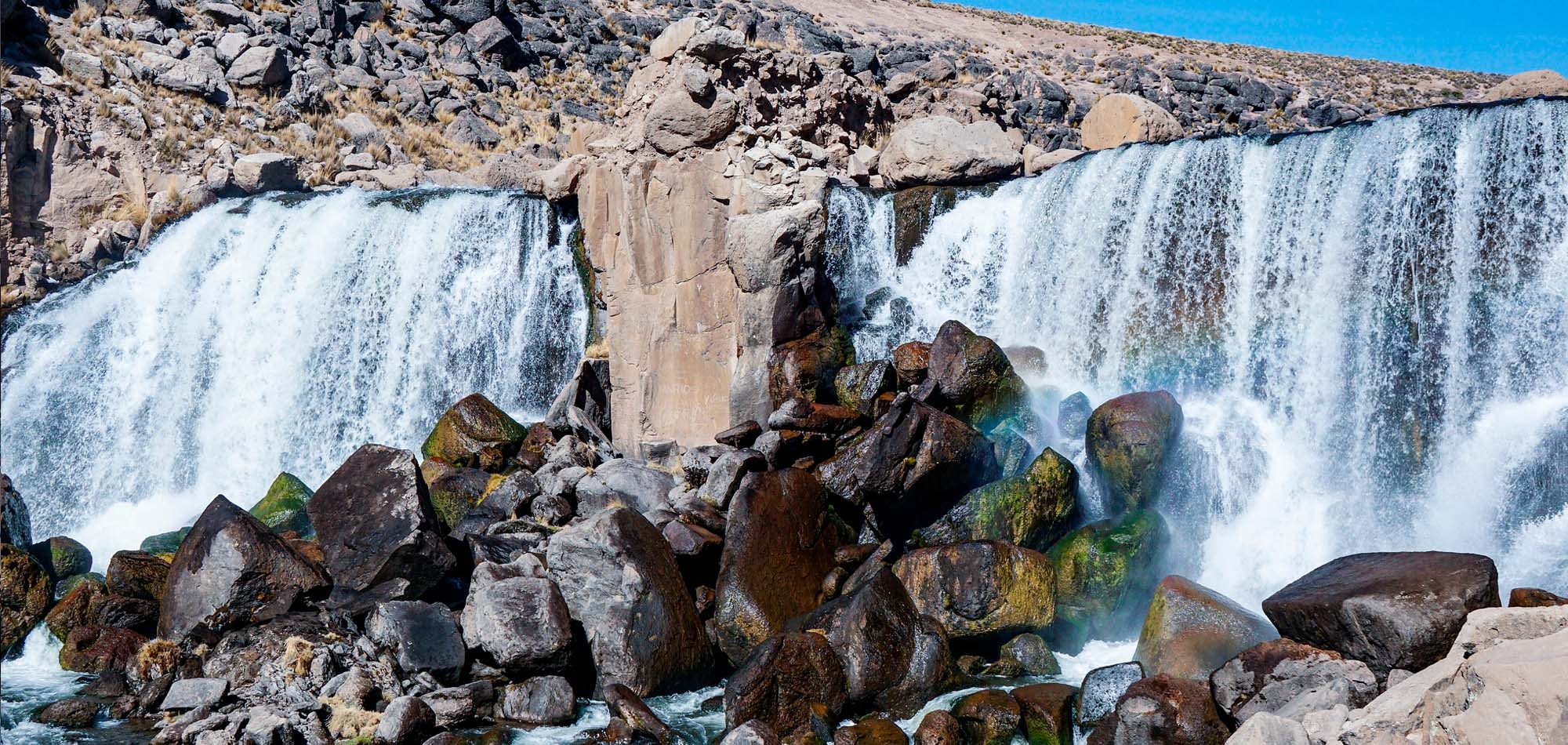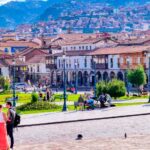Pillones waterfall and Imata stone forest

Arequipa offers a great diversity of natural tourist destinations. The Pillones waterfall is a huge waterfall that stands out for its beauty. Likewise, the Imata stone forest has rock formations of volcanic material which, products of wind erosion, were sculpted by the wind in different shapes, such as men, animals, birds, monsters and more. Due to the proximity, both sites are included in a single 1 day tour that departs from the city of Arequipa. It is one of the most famous natural tourist attractions in Arequipa.
Description
The Pillones waterfalls are one of the most beautiful landscapes in Arequipa. In the middle of the arid desert at more than 4,200 meters above sea level, there is an extensive waterfall 10 meters high. Around the falls are rocks of volcanic origin that offer a striking landscape. The place is inhabited by different species of flora and fauna.
The stone forest of Pillones, located near the falls, offers a surreal landscape. The rock formations that can be seen there originated thousands of years ago as a result of volcanic eruptions and wind erosion. The figures of animals, birds, men as well as famous structures such as the dimensional portal of Imata stand out.
Where it is located?
Both tourist attractions are located approximately 150 kilometers from the city of Arequipa, in southern Peru. Both places belong to the district of San Antonio de Chuca, province of Caylloma.
Arequipa is famous for its stone forests, product of the rockslide during volcanic eruptions. In addition to Imata, the Choqolaqa stone forest is one of the most visited natural tourist attractions. Its landscapes are fascinating. There you can see figures of seals, angels, castles, towers, streets and even women. It is an excellent option for taking pictures.
How to go to Pillones waterfall?
To visit both places, you must start from the city of Arequipa on the road towards Puno until a detour at kilometer 154. From there you have to do a 1 kilometer walk until you descend on the left bank of the river where the Pillones waterfalls are located. From there you continue by car until you arrive at the Imata stone forest.
Map
The Imata stone forest
This stone forest receives its name because it is located in the town of Imata, district of San Antonio de Chuca. This high Andean area is located near imposing volcanoes, which caused the eruption and the appearance of several blocks of volcanic stone thousands of years ago. The erosion of the wind, as well as the rain and the sun; later, it caused the formation of different surreal figures. The shapes of men, animals, birds and more stand out. The place also offers a great diversity of animals and plants, such as the vizcacha, the Andean condor, the vicuña, the icchu and more. The whole set resembles a masterpiece of abstract art made by nature.
The Pillones waterfalls
In the town of Pillones, in the district of San Antonio de Chuca, the Pillones waterfalls are a waterfall of great dimensions in width and height. You get there by a pleasant 1 kilometer walk. The place is home to vizcachas, mountain ducks, huallatas, swallows and other Andean animals and birds. However, the great attraction is the waterfall, which offers one of the most pleasant views of Arequipa.

Flora
Due to the high Andean location (above 4,200 meters above sea level) there are not many species of flora both in the Pillones waterfalls and in the Imata stone forest. The icchu, wild straw from the Andes that grows in high altitude geographies, is the plant that is most established in the place. This wild grass serves as food for the numerous vicuñas and other camelids that inhabit the site.
Fauna
Both the Imata stone forest and the Pillones waterfalls are home to different species of Andean animals, such as: the torrent duck, the huallata, the vizcachas, the vicuñas, the swallows and more.
How much does it cost to go?
The tours to the Pillones waterfalls and the Imata stone forest have a cost of 90 Peruvian soles, approximately (about 30 US dollars on average). All services include: transportation, tickets and tour guide.
Another way to visit these tourist attractions is to go on your own. To do this, you must take public transport to the town of San Antonio de Chuca. After walking towards the Pillones waterfalls, you must pay the entrance fee to the place (2 Peruvian soles).
Climate
The climate in the Pillones waterfalls as well as the Imata stone forest is cold. Due to its high Andean geography, the minimum temperature (at night) can drop to -4ºC. During the day, the maximum temperature can reach 15ºC. The rainy season happens from November to February. The rest of the year, the rains are not frequent, it is the dry season.
What to bring
- Warm clothes.
- Cap or hat.
- Sunscreen.
- Comfortable shoes for the walk.
- Poncho for rain.
- Extra money.
- Documents
- Photographic camera.
Tips
During your visit to the Pillones waterfalls as well as the Imata stone forest, you may suffer from the symptoms of altitude sickness, also called mountain sickness (nausea, fatigue, shortness of breath when exerting physical effort). This is due to the high Andean geography of low oxygen. It is recommended to drink plenty of water and adapt to the Arequipa climate, at least 1 or 2 days before your visit.
According to specialist tour guides, the best time of year to visit is during the dry season months (especially from April to October). On those days rains are not common, so the climate is ideal for hiking. February is the rainiest month.
More information
During the tours to the Pillones waterfalls and the Imata stone forest, the tourist will make a stop in Zamacola, Pampa de Arrieros and the Cañahuas pampa. In these places, the visitor will be able to appreciate the vicuñas (Andean camelids with fine fur) that inhabit the Salinas and Aguada Blanca National Reserve.
The Imata stone forest is part of the so-called ‘Mauca Arequipa’ (small Arequipa in the Quechua language). Legend has it, the gods punished an ancient city for disobeying them. As a result, today you can see the different stone formations that resemble an ancient city.

